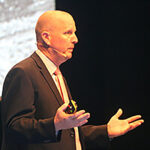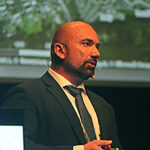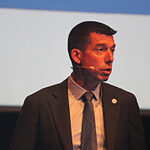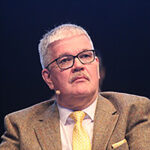ESPHM: From PRRS to ASF and pig welfare

It was a great relief and joy for the swine veterinary community in Europe to gather again in the first major event after Covid-19. The first edition of the European Symposium for Porcine Health Management (ESPHM), held on May 11-13 in Budapest, Hungary, focused on a diversity of pig health subjects, from PRRS to ASF and pig welfare. A short recap of the ESPHM in a review of the 8 keynote speakers.

Prof Jim Lowe, University of Illinois, USA, kicked off the session “How to deal with a large crisis?” and presented an intriguing picture of what the pig production supply chain entails in the US market – from pig production (11 months) to the packer and processor (4 to 7 days), to retail (1 to 10 days) and then the consumer.
He described it as “simple but just in time” – a system that gets into trouble as soon as there is a disruption in the system. He pointed to recent crises like for instance swine influenza (2008), PEDv (2014), and Covid (2019), each disrupting the supply chain in its own way. This could be solved by having attention for our customers’ customers, he said, by working with buffers and by spending more energy on precision production. He said, “Mitigating the impact of future crises on animal-based food production will require re-engineering our production systems to husbandry systems that integrate technologies to monitor, understand and improve the underlying biology of the animals under our care.”

Eradication of African Swine Fever in the Czech Republic
Talking about major crises in practice was Dr Petr Satran, of the Czech State Veterinary Authority. He spoke about how the country managed to eradicate African Swine Fever from its territory, when it occurred in the wild boar population near Zlín, Hungary in 2017.
To date, together with Belgium, the Czech Republic is the only country that has managed to eradicate the virus from its territory. He described how the Czech Republic had tackled this crisis and emphasised the importance of removing infected carcasses. “If you find the first case, remember that it might not be the first case at all. You do not know what else there is.”
He proceeded to explain that for good disease control, they ideally needed to have a density of 0.5 wild boar per km2. In truth, at the start of the ASF outbreaks, there was no clear picture of the true wild boar density in the Zlín area. Having fenced the infected area, the wild boar density in that area of 57 km2 turned out to be 9.1 km2.

Definition of an eradication programme
The second day of the event kicked off with a presentation of Dr Heiko Nathues of the Vetsuisse Faculty at the University of Bern, Switzerland. He wondered how an eradication programme could be defined. The design of a tailor-made eradication programme would be the result of a sequence of steps, he said. First, it would start with the understanding of the epidemiology of an infection. Secondly, the socio-economic value of an eradication would have to be evaluated. Thirdly, sustainable eradication concepts should be applied.
As an example, he discussed pros and cons of for instance depop-repop, close and roll-over, test and removal and mass treatment. Fourth and last, he added, a sampling strategy would have to be designed to control the success. That all in the end would lead to a tailor-made eradication programme.

PRRS in Hungary
One good example of an eradication programme was the way Hungary dealt with Porcine Reproductive and Respiratory Syndrome (PRRS), described by Dr István Szabó, University of Veterinary Medicine, Budapest, Hungary. The country became negative for PRRSv in 2022 after a programme that lasted many years, starting in 2014. Hungary, he describes is a country with 150,000 sows, spread out over 800 farms (backyard production not included). For the industry, elimination of PRRS would mean that it reduced the losses due to PRRS, it would decrease antibiotic usage as well as increase the competitiveness of the sector as a whole.
A surveillance programme was started in 2012 – participation to the eradication programme was compulsory. It was organised on a county level – and the country started in the areas where there would not be the highest pig density. Participating farms had the choice of which method would be followed to eradicate, by depop-repop, by test and removal or by herd closure. He shared data as to how the percentage of farms testing positive came down to zero. Investment for the state was around €7 million, plus between €1.7-2.2 million per year in compensation between 2014 and 2022.

Healthy pigs, healthy humans
In the session called “Healthy pigs, healthy humans”, assistant professor Tijs Tobias of Utrecht University, the Netherlands made a side step to mink, another animal species kept in agriculture – one that disappeared in the Netherlands during Covid-19. Mink were found to be susceptible to Covid-19. Since the industry was about to be closed down in 2023 for tightened animal welfare legislation, it was decided to depopulate sooner. In the Netherlands, farms had had a size of between 500 and 120,000 mink per farm. He also discussed the difference between findings of Covid-19 in Danish mink farms and those in the Netherlands – and how both countries dealt with the pressure differently. Then he addressed the big elephant in the room: “What if this would happen to pigs? Do we have to worry?”
He pointed to the fact that pork is food – unlike with mink production, even though that does not guarantee a mild control. He added that effective measures would have to be inevitable, where prevention of transmission and evolution plays an important role.

Influenza viruses
Prof Timm Harder of the Friedrich-Loeffler-Institut in Germany addressed another potential zoonosis: influenza viruses. He discussed the traditional model of the pig being a mixing vessel and wondered whether or not that really holds true for pigs. It is clear that influenza viruses tend to change, but he added that there is a difference between how human and porcine influenza viruses change. The speed in pigs is not fast, he said, it would involve only little by little. So he wondered how strong the “reverse zoonotic transmission” would be, that it jumps back from pigs to humans.
He concluded that pigs have proven to be involved in 1 out of 5 human pandemics, but also pointed to the fact that also other mixing vessels exist. Lastly, he emphasised the importance of vaccination.

Sustainable pig production
The last day was reserved for a session on “sustainable pig production,” with Dr Jörg Altemeier speaking first. He is head of the animal welfare and animal health unit of the Tönnies Group, one of Germany’s largest meatpackers. He summed up various factors that may or may not affect pig prices in Germany. He touched on Salmonella, feed prices, African Swine Fever, current developments in labelling better husbandry and higher welfare standards – and he also touched on the effect of reports about animal welfare violation.
He quoted the German agricultural title Top Agrar in pointing to a reduction of pig meat consumption when comparing 2021 to 10 years before. Beef and poultry consumption, however, went up in that decade. He also showed how pig slaughterings have come down, from 49 million in 2018 to 43 million in 2021. He commented, “Slauthering is going down. Maybe it is one of the effects of ongoing media reports. For us, it is clear that all of us have to change their mind. He pointed to best practices that would be needed for reasons of ethics, animal welfare, hygiene, biosecurity and the environment. In other words: sustainability.

3 pillars of sustainability
The last key-note speaker at ESPHM was Ricardo Neto, DVM, technical service manager health, western & southern Europe at Kemin. He discussed the company’s attention to intestinal health, and how the 3 pillars of sustainability would have to be transferred to the swine industry: healthy people, healthy planet and a healthy business. For the company, this translated to antibiotic reduction, the ban of zinc oxide at high doses as well as finding feed sources with the right environmental impact which are also affordable – a puzzle that needs to be fitting. He also discussed various solutions the company is offering.











